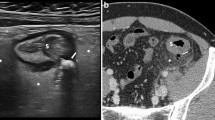Abstract.
The aim of this study was to compare the performance of the CT and the water-soluble contrast enema (CE) in the diagnosis and the severity of acute left-colonic diverticulitis, and to recognize the impact of CT during the acute phase and after a first acute episode successfully treated medically. From 1986 to 1997, all patients admitted in our emergency center with clinically suspected left-colonic diverticulitis had a CE and a CT within 72 h of their admission, unless clinical findings required immediate laparotomy. They were prospectively included in the study if one or both radiological exams showed signs of acute diverticulitis and/or diverticulitis was surgically removed and histologically proven. Diverticulitis was considered moderate when CT showed localized thickening of the colonic wall (5 mm or more) and inflammation of pericolic fat and CE showed segmental lumen narrowing and tethered mucosa; it was considered severe when abscess and/or extraluminal air and/or contrast were observed on CT and when one or both of the latter signs were seen on CE. Five hundred forty-two patients entered the study; 465 patients (86%) had a CT exam, 439 (81%) had a CE, and 420 (77%) had both exams. The performance of CT is significantly superior to CE in terms of sensitivity (98 vs 92%, p<0.01), and in the evaluation of the severity of the inflammation (26 vs 9%, p<0.02). Moreover, of 69 patients who had an associated abscess seen on CT, only 20 (29%) had indirect signs of this complication on CE. During the acute phase the chances of medical treatment failure are statistically greater when diverticulitis is considered severe on CT than when it is considered moderate (26% for the severe diverticulitis vs 4% for the moderate ones, p<0.0001). After successful medical treatment of the acute episode, patients with severe diverticulitis on the CT had statistically greater incidence of secondary bad outcome than patients with moderate diverticulitis (36 vs 17%, p<0.0001). Computed tomography should be preferred to CE as the initial radiological exam of diverticulitis because of its statistically significant superiority in sensitivity and for its statistically much higher performance in the detection of severe infection, especially when an abscess is associated with the disease. The severity of diverticulitis on CT is statistically predictive of the risk of medical treatment failure during the acute phase and of the chances of bad secondary outcome after a successful medical treatment of the first episode.
Similar content being viewed by others
Author information
Authors and Affiliations
Additional information
Electronic Publication
Rights and permissions
About this article
Cite this article
Ambrosetti, P., Becker, C. & Terrier, F. Colonic diverticulitis: impact of imaging on surgical management – a prospective study of 542 patients. Eur Radiol 12, 1145–1149 (2002). https://doi.org/10.1007/s00330-001-1143-y
Received:
Revised:
Accepted:
Published:
Issue Date:
DOI: https://doi.org/10.1007/s00330-001-1143-y




